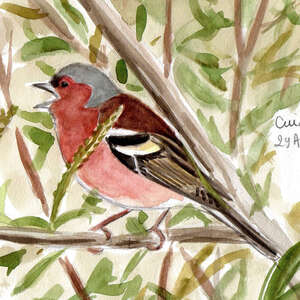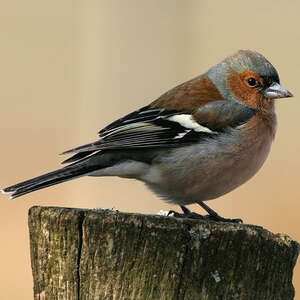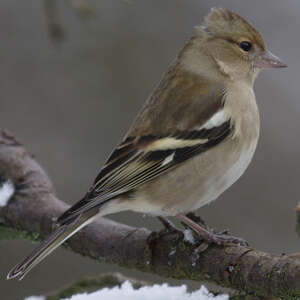Eurasian Chaffinch
Fringilla coelebs - Pinson des arbres
Identification
The Common Chaffinch is a common and easy to recognize passerine. The adult male nuptial is rather showy. The mantle and the upper back are warm brown-maroon. The head is slate grey, except for the black forehead and the lores, cheeks and ear coverts which is chestnut. The beak is blue-grey. Two wide white bands separated by black on the wing covers are diagnostic and very visible, when perched or in flight. The large covers often tend to light yellow. The dark remiges are bordered with yellow. The rump and the uppertail covers are olive. The dark tail shows white in the two pairs of external rectrices. The lower parts are brightly pinkish, sometimes with an orange-brown tinge. The underbelly and the undertail covers are white. The legs are pinkish. In winter, the colors are muted and it is the wear of the plumage that will reveal the underlying beautiful colors for reproduction.
The female has much less striking plumage. The mantle is dull brown. The head and underside are beige shaded with gray, except for the undertail coverts which are white. The crown is darker, often with a brighter median line. The eye is circled in white. The beak is pinkish or horn gray. The wings bear the same white bars and the tail bears the same white external rectrices as the male, but the white is less expansive. The rump is also greenish.
The juvenile is even more dull than the female. Fortunately, the white wings and tail make it recognizable. It has a pale spot on the nape.
In the Macaronesian islands and in North Africa, well differentiated subspecies of the type ssp are found. They are darker above (blue head and green or blue mantle) and the underside is paler, more salmon-colored than pinkish.
Subspecific information 7 subspecies
- Fringilla coelebs coelebs (Europe. except British Isles, Sardinia. to c Asia, w, n Turkey, c and e Caucasus and nw Iran.)
- Fringilla coelebs gengleri (British Isles)
- Fringilla coelebs solomkoi (Crimea and sw Caucasus)
- Fringilla coelebs sarda (Sardinia)
- Fringilla coelebs syriaca (Cyprus, se Turkey to n Iraq and Jordan)
- Fringilla coelebs alexandrovi (n Iran)
- Fringilla coelebs transcaspia (ne Iran and sw Turkmenistan)
Foreign names
- Pinson des arbres,
- Pinzón vulgar,
- tentilhão-comum,
- Buchfink,
- erdei pinty,
- Vink,
- Fringuello,
- bofink,
- Bokfink,
- pinka obyčajná,
- pěnkava obecná,
- Bogfinke,
- peippo,
- Gryskoppie,
- pinsà comú,
- Bókfinka,
- zięba (zwyczajna),
- žubīte,
- ščinkavec,
- Зяблик,
- ズアオアトリ,
- 苍头燕雀,
- นกจาบปีกอ่อนหัวเทาอกชมพู,
- 蒼頭燕雀,
Voice song and call
The usual call is a loud fink, often repeated two or three times. It is a contact call between individuals. A strong, rolling trrriii can be considered an alarm call. In flight, a typical tiup is repeated regularly, for example from migrants during active migration.
The song is stereotyped and relatively constant within the species. It is a sound phrase which can be translated as tji tji tji tji tiup tjiup tjiup tjiup tu tu tu ui tu.
Habitat
The Common Chaffinch is a typically forest species, but it is capable of adapting to a wide range of habitats.
Migrants also frequent open environments, particularly crops, during migratory stopovers, in search of seeds from which they draw their energy. In case of danger, they take refuge in nearby hedges and thickets.
Behaviour character trait
Common Chaffinch is a sociable bird, except during reproduction. At this time, it becomes territorial and males vigorously defend their territory, marking it with their song.
This is why males sing mostly in evidence on a high perch.On the ground where he seeks his food, the Common Chaffinch moves hopping. When he is not on the ground, he is clinging to the trees. He is arboreal for reproduction. The nest is built on a branch, generally well camouflaged.
Our Chaffinches are often sedentary or at least errant, and are visible all year round. It can also be noted that in Western Europe, during the two migrations, the Common Chaffinch is the species that always dominates in number. These are waves of thousands of birds that pass. These migrations concern birds from high latitudes wintering further south. It is them that can be seen in large numbers in the fields in March and October.
A original behavior trait to be highlighted in this species is the segregation that occurs in the inter-nesting period. Males on one side, females and young on the other, form separate groups, which migrate separately, feed separately during stops. It is this characteristic trait that is translated into the scientific name of the species, namely coelebs, which means single.
Flight
Dietfeeding habits
The Common Chaffinch is an omnivore, which certainly helps to explain its abundance. Its diet varies according to the season; during warmer months it is mostly insectivorous.
Young birds are completely fed invertebrates. The variety of animal prey is extremely diverse, comprising mostly insects and their larvae. During the inter-nuptial season, seeds predominate in the diet. Seeds provide the energy needed for migrating birds. Besides this, they also consume flowers and buds, which are high in proteins and carbohydrates.Reproduction nesting
Starting in March and April, the female Common Chaffinch builds the nest on the territory that the male defends with its voice.
This work is hers as the male is completely occupied with defending the territory. The nest is built relatively high in a tree with many branches, in a fork or on a branch, and is in one piece with its support. It is made from moss, plant fibers and roots, all assembled with spider silk. An external coating of lichen is normal. The interior is lined with feathers and hairs. The whole is a well-done, rather small work for the size of the bird and which blends in with its mossy bark or lichen environment.The female lays 4 to 5 blue and dotted eggs of 20 x 14 mm which she incubates alone for 12 to 14 days. The parents take care of the rearing of the young together and feed them mainly on arthropod (mostly insects). The stay in the nest is about 15 days. The success in flying away is on average 3 to 4 young per successful clutch. Once the first clutch is emancipated, the chaffinches have time to start a second reproduction due to the precocity of the first. The flight takes place in June-July.
Geographic range
The Common Chaffinch is a species from western Eurasia. Its range extends from western Europe to Central Siberia, reaching Lake Baikal in the east. It extends northwards to the far north of the Scandinavian Peninsula and western Siberia. In the south, well-defined subspecies occur in the Macaronesia islands (Azores, Madeira and the Canaries) and the far north of Africa. The northern and eastern populations are partial migrants, wintering in temperate and Mediterranean climates, without extending beyond their breeding range, except locally in the east.
Threats - protection
IUCN conservation status
concern
in the Wild
threatened
evaluated
This species, largely found in forests, is very common and not threatened. Recent studies have shown that the current decline of passerines mainly affects species in open habitats, particularly agricultural ones. Forest birds are less affected.
Sources of information
- IOC World Bird List (v15.1), Gill, F and D Donsker (Eds). 2025-12-07.
Other sources of interest
 Specification sheet created on
06/07/2023 by Jean François
Specification sheet created on
06/07/2023 by Jean FrançoisTranslation by AI Oiseaux.net
© 1996-2026 Oiseaux.net
- Accipitriformes
- Aegotheliformes
- Anseriformes
- Apodiformes
- Apterygiformes
- Bucerotiformes
- Caprimulgiformes
- Cariamiformes
- Casuariiformes
- Charadriiformes
- Ciconiiformes
- Coliiformes
- Columbiformes
- Coraciiformes
- Cuculiformes
- Eurypygiformes
- Falconiformes
- Galliformes
- Gaviiformes
- Gruiformes
- Leptosomiformes
- Mesitornithiformes
- Musophagiformes
- Nyctibiiformes
- Opisthocomiformes
- Otidiformes
- Passeriformes
- Pelecaniformes
- Phaethontiformes
- Phoenicopteriformes
- Piciformes
- Podargiformes
- Podicipediformes
- Procellariiformes
- Psittaciformes
- Pterocliformes
- Rheiformes
- Sphenisciformes
- Steatornithiformes
- Strigiformes
- Struthioniformes
- Suliformes
- Tinamiformes
- Trogoniformes

































